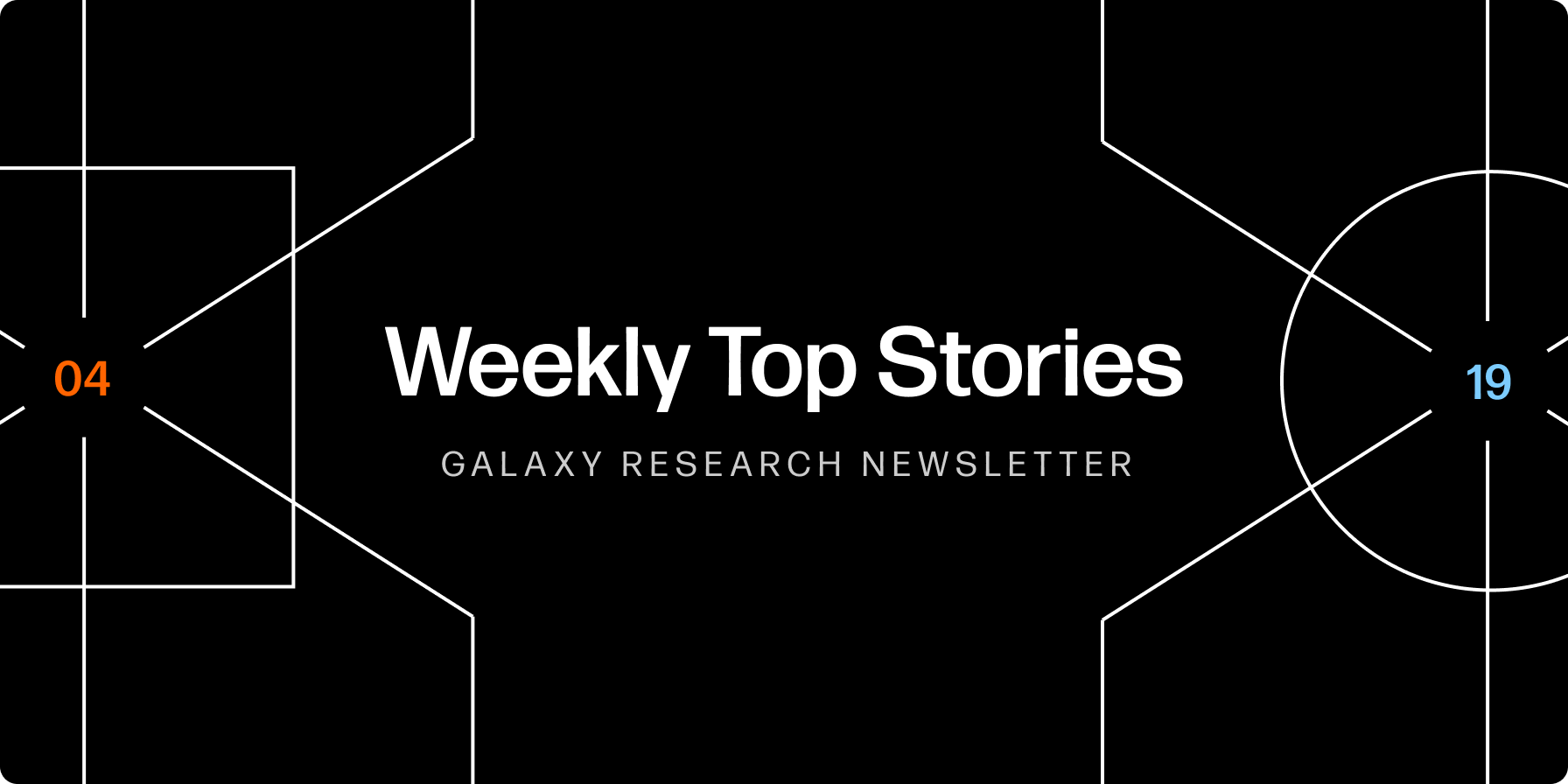Top Stories of the Week - 4/19

This week in the newsletter, we write about Bitcoin’s fourth halving, Senators Cynthia Lummis and Kirsten Gillibrand introducing new stablecoin legislation, and Lido onboarding 72 new DVT node operators.
Subscribe here and receive Galaxy's Weekly Top Stories, and more, directly to your inbox.
The Bitcoin Halving is Here
Bitcoin is now less than 24 hours away from its fourth halving that will occur at block number 840,000. At the halving, Bitcoin’s block subsidy, the number of newly issued bitcoins paid to the miner of each block will decrease from 6.25 BTC to 3.125 BTC. Consequently, the daily issuance of new bitcoins will decrease from ~900 BTC to ~450 BTC, lowering bitcoin’s annualized inflation to 0.85%.
The halving is a programmed event on Bitcoin that occurs every 210,000 blocks, approximately every four years. Bitcoin will undergo 30 more halvings after its fourth halving on April 20, 2024.
The halving is also a crucial event for Bitcoin miners as the block subsidy is a key source of revenue, with transaction fees being the other. However, over the 15 years Bitcoin has operated, fees have never comprised more than 12% of miner revenue (and that year, 2017, was an outlier — 3-6% has been the norm for several years). Holding bitcoin price and network hashrate constant, this results in Bitcoin miner revenues cutting in half at the halving. As a result, mining operations are actively maximizing ways to increase efficiency prior to the halving.
To read more about the halving, Galaxy Research published a new report explaining how the halving works and its importance to Bitcoin’s transparent monetary policy.
OUR TAKE:
The transparency and predictability of Bitcoin’s issuance is a key characteristic that separates the asset from any other asset or currency in the world. The 50% reduction in Bitcoin’s block reward makes bitcoin scarcer overall as an asset while likely reducing the absolute amount of selling pressure from miners. However, the reduction in issuance is relatively small at this point — reducing from 900 BTC to 450 BTC per day — when compared to Bitcoin’s daily float of $10-25bn. Nonetheless, prices are set on the margin and the reduction should still have a marginal positive impact on buy/sell ratios. Regardless, though, the halving is an automated, programmed event that serves as a quadrennial marketing moment for Bitcoin, again and again proving that a credibly deflationary monetary policy can exist and its asset can thrive. This stands in stark contrast to the perpetually inflating fiat currencies that dominate the world today. To read more about Bitcoin’s fourth halving, read Galaxy Research’s new halving report. - Gabe Parker
Lummis & Gillibrand Introduce New Stablecoin Bill
On Wednesday, Senators Cynthia Lummis and Kirsten Gillibrand introduced the Lummis-Gillibrand Payment Stablecoin Act, proposing a regulatory framework for stablecoins in the United States. The bill defines a payment stablecoin as tokens for which the issuer is "obligated to convert, redeem, or repurchase for a fixed amount of United States dollars" and specifically excludes algorithmic stablecoins.
The bill has both a state and federal pathway for depository and non-depository institutions to issue up to $10 billion in stablecoins, although non-depository institutions who exceed that threshold would need to convert to depository institutions. Oversight responsibilities are assigned to both state and federal regulators, with federal regulators having the authority to take unilateral action against issuers larger than $10 billion and requiring joint action for issuers under $10 billion.
The bill emphasizes custody and third-party risk management, noting that proper custody practices for issuers are essential, especially in light of events like FTX. It mandates specific regulations governing reserve requirements and operational practices, including requirements for depository institutions to form separate companies for stablecoin issuance and for non-depository trust companies to use a sub-custodian that is a depository institution.
Senators Lummis and Gillibrand had previously introduced the Responsible Financial Innovation Act in 2022, proposing a comprehensive regulatory framework for digital assets such as Bitcoin and Ether, as well as stablecoins. In July 2023, they reintroduced an updated version of their market structure bill, notably clarifying the division of digital asset supervision between the SEC and the CFTC, a continuing area of controversy. However, these bills have not yet gained significant traction.
Our Take:
The bipartisan bill marks a significant acknowledgment of blockchain technology's value as a foundational payments infrastructure and stablecoins as a viable medium of exchange. In a separate op-ed published on CoinDesk, Senators Lummis and Gillibrand emphasized the benefits of sending stablecoins globally at a fraction of the cost of traditional providers, and the potential for entrepreneurs to develop innovative applications and use cases.
The bill would impact major US stablecoin issuers like Circle, which are not depository trust institutions and have issued over $10 billion in stablecoins. Under the proposed legislation, such entities would need to seek such licenses to continue operating. Issuers of more exotic stablecoins not backed one-to-one by acceptable collateral, like Maker’s DAI or Ethena’s sUSDe, seem to have no clear path toward registration. Furthermore, the bill calls on institutions like the Federal Reserve, OCC, and state bank supervisors to establish interoperability standards, which are unlikely to align with existing permissionless blockchains like Ethereum.
While the bill contributes positively to the momentum for advancing crypto regulatory frameworks, it faces significant procedural and political obstacles. On the day the bill was introduced, for example, Senator Warren sent a letter to Treasury Secretary Yellen arguing that integrating stablecoins more deeply into the banking system could boost trading in the crypto market and enhance opportunities for sanctioned entities and the criminal underground (a deeper overview can be found here). This ongoing push from Sen. Warren enhances the likelihood that illicit finance provisions are likely to be added to the bill at some stage. Additionally, with the summer recess already approaching and the significant amount of floor time required to actually advance legislation, any bill will face significant competition from other more important legislation.
The bill is positive in that it preserves a state pathway for registration (i.e., it does not prohibit states from licensing issuers) and that its prudential requirements (i.e., reserve composition, prohibitions on rehypothecation, etc.) provide good consumer safety measures. These provisions are generally also in-line with those put favored by the House Financial Services Committee, whose current Chairman Patrick McHenry is also keen to move legislation on stablecoins before he retires at the end of the year. However, it is worth noting that Columbia University professor and former portfolio manager for Paxos’ USDP stablecoin Austin Campbell pointed out that the specificity of reserve requirements as written would create unworkable liquidity and operational challenges.
But the language isn’t final and, if it can advance in the Senate Banking Committee, there will almost certainly be changes. And while the bill as written is undoubtedly an earnest bipartisan proposal one cannot look at the statement from Senator Brown (Chairman of the Banking Committee), the release of Sen. Warren’s latest AML letter, etc., and not be left with the impression that this is an yet-to-be finished work-product designed to spur action on the topic more than be the final proposal.
Time and again US regulators have over-indexed on the negatives of blockchains and digital assets. This bill, while far from perfect, is a refreshing acknowledgement that there is a path forward for digital asset regulations that attempt to harness its advantages while limiting its risks. If it’s introduction can reignite chances of getting progressive legislation done this year, that would be a positive for maintaining American innovation, supporting the dollar, enshrining a new much-needed source of T-bill buyers, and promote the use of public blockchains. However, with the calendar like it is and the politics like they are, we peg the likelihood that this becomes law this year at 20% or lower. – Alex Thorn and Lucas Tcheyan
Lido Onboards 72 New DVT Node Operators
The number of Lido node operators has nearly tripled increasing from 37 to 109 with the addition of 72 net-new operators. On Tuesday, April 16, 2024, the Lido DAO announced that the Lido protocol has officially launched the “Simple DVT Module,” which is a subset of Lido node operators that will be running distributed validator technology (DVT) to improve Lido’s decentralization and security. To learn more about DVT and the Simple DVT Module, listen to this episode of the Infinite Jungle podcast. As highlighted in a prior Galaxy Research newsletter, the launch of the Simple DVT Module was approved through a LDO token governance vote organized by the Lido DAO back in November 2023. Two DVT software providers, Obol and SSV, were selected to test and onboard the operators for the Simple DVT Module.
After several months of testing, the first 10 clusters of Obol DVT node operators (NOs) have now gone live on Lido. All net-new ETH deposits into Lido will be automatically directed to Obol DVT NOs and Lido liquid staking token holders will start earning rewards through these operators. There are still 14 clusters of Obol DVT NOs, about 98 NOs, still to be onboarded to Lido over the coming weeks. Additionally, there are clusters of SSV DVT NOs that are pending activation starting in May. The Lido DAO wrote in a blog post on Tuesday that the Simple DVT Module is set to add a total of 250 net-new NOs from Obol and SSV combined, which would represent a 676% growth in the number of NOs on Lido.
Given that DVT is a relatively experimental staking technology that is being used by Lido for the first time, the Lido DAO has voted to cap the amount staked through the Simple DVT module to 0.5% of total ETH staked through Lido. At time of writing, 0.5% of total ETH staked in Lido is equivalent to roughly 46,683 ETH or $143m. The performance of validators managed through the Simple DVT Module will be assessed by the Lido DAO over the coming months and depending on the data, LDO token holders may vote to increase the cap and onboard more NOs to the Simple DVT Module.
OUR TAKE:
The Simple DVT Module is the first largescale implementation of DVT on Ethereum. It is a major milestone for DVT software providers like Obol and SSV, as well as for the Lido DAO that has been working for years towards meaningfully decentralizing its node operator set. With the addition of 72 new Obol DVT NOs, and 110 more still to be onboarded, along with at least 68 SSV DVT NOs, the number of Lido NOs is set to grow over the next few months by almost 700%. While the amount of stake under management by these new NOs remain capped and small relative to the total amount of ETH staked through Lido, this is an impressive step forward for the adoption of DVT and the decentralization of the Lido protocol.
It will be important to watch how the NOs in the Simple DVT Module perform against the 37 NOs in the normal, also called “Curated”, Lido staking module. The Curated module manages 99.5% of total ETH staked in Lido. Based on the most recent testnet metrics, Obol DVT NOs surpass the minimum criteria for successful validating as defined by the Lido DAO by having an uptime higher than 95%, a block proposal success rate above 70%, and an attestation effectiveness of over 80%. Assuming Obol DVT NOs maintain these levels on Ethereum mainnet over the coming months, it won’t be long before another governance proposal is created by Lido DAO members to increase the module cap from 0.5% to up to 2%, possibly before the end of this year. Also, depending on how seamlessly the Simple DVT Module operates, especially for rewards accrual and stETH redemptions, there may be increased support for and conversation about proposals to launch other types of experimental staking modules to further enhance the flexibility and decentralization of the Lido protocol. - Christine Kim
Charts of the Week
The number of daily active addresses (DAAs) using notable Ethereum Layer 2s (L2s) reached an all-time high of 1.9 million active addresses on March 31, 2024. As of April 18, 20204 there are 1.34 million daily active addresses. The chart below includes daily active addresses for Arbitrum, Optimism, zkSync Era, Linea, Base, Scroll, and Zora, and categorizes them by addresses that appear on one L2 and those that appear on more than one L2 each day. While the outright number of DAAs on these networks has come off its all-time high by 44% over the last three weeks, the share of DAAs using multiple L2s is near all-time highs.

The chart below highlights the share of L2 DAAs that appear on multiple chains each day. Nearly a quarter of all active addresses – 306,000 addresses – across the observed L2s appeared on more than one chain as of April 18, 2024. The hyperactivity of addresses across L2s can be attributed to speculative airdrop farming across the chains and the bridges that enable users to move between L2s. It can also be attributed to the fragmentation of use cases across L2s: that is, some L2s might offer apps or capabilities that others don’t, forcing users to move between chains to satisfy their needs.

Other News
Avraham 'Avi' Eisenberg convicted for $110 million Mango Markets exploit
Runes hype pushes transaction fees on Bitcoin higher
TikTok owner ByteDance's tech arm collaborating with Sui builders on web3 gaming, socialFi
Worldcoin will launch its own Layer 2 blockchain called World Chain
Bored Apes' floor price hits lowest point since 2021, down more than 90% from all-time high
Hong Kong regulators approve launch of spot bitcoin and ether ETFs
Solana patch aims to help alleviate ongoing network congestion issues
EigenLayer removed LST caps, opened LST restaking
Legal Disclosure:
This document, and the information contained herein, has been provided to you by Galaxy Digital Holdings LP and its affiliates (“Galaxy Digital”) solely for informational purposes. This document may not be reproduced or redistributed in whole or in part, in any format, without the express written approval of Galaxy Digital. Neither the information, nor any opinion contained in this document, constitutes an offer to buy or sell, or a solicitation of an offer to buy or sell, any advisory services, securities, futures, options or other financial instruments or to participate in any advisory services or trading strategy. Nothing contained in this document constitutes investment, legal or tax advice or is an endorsement of any of the stablecoins mentioned herein. You should make your own investigations and evaluations of the information herein. Any decisions based on information contained in this document are the sole responsibility of the reader. Certain statements in this document reflect Galaxy Digital’s views, estimates, opinions or predictions (which may be based on proprietary models and assumptions, including, in particular, Galaxy Digital’s views on the current and future market for certain digital assets), and there is no guarantee that these views, estimates, opinions or predictions are currently accurate or that they will be ultimately realized. To the extent these assumptions or models are not correct or circumstances change, the actual performance may vary substantially from, and be less than, the estimates included herein. None of Galaxy Digital nor any of its affiliates, shareholders, partners, members, directors, officers, management, employees or representatives makes any representation or warranty, express or implied, as to the accuracy or completeness of any of the information or any other information (whether communicated in written or oral form) transmitted or made available to you. Each of the aforementioned parties expressly disclaims any and all liability relating to or resulting from the use of this information. Certain information contained herein (including financial information) has been obtained from published and non-published sources. Such information has not been independently verified by Galaxy Digital and, Galaxy Digital, does not assume responsibility for the accuracy of such information. Affiliates of Galaxy Digital may have owned, hedged and sold or may own, hedge and sell investments in some of the digital assets and protocols discussed in this document. Except where otherwise indicated, the information in this document is based on matters as they exist as of the date of preparation and not as of any future date, and will not be updated or otherwise revised to reflect information that subsequently becomes available, or circumstances existing or changes occurring after the date hereof. This document provides links to other Websites that we think might be of interest to you. Please note that when you click on one of these links, you may be moving to a provider’s website that is not associated with Galaxy Digital. These linked sites and their providers are not controlled by us, and we are not responsible for the contents or the proper operation of any linked site. The inclusion of any link does not imply our endorsement or our adoption of the statements therein. We encourage you to read the terms of use and privacy statements of these linked sites as their policies may differ from ours. The foregoing does not constitute a “research report” as defined by FINRA Rule 2241 or a “debt research report” as defined by FINRA Rule 2242 and was not prepared by Galaxy Digital Partners LLC. For all inquiries, please email [email protected]. ©Copyright Galaxy Digital Holdings LP 2024. All rights reserved.





